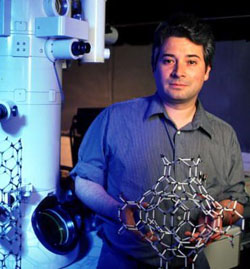Dr. Humberto Terrones
Humberto Terrones, Ph.D. is Professor at the Investigación Científica y Tecnológica (IPICYT) in Mexico, is a leading researcher with a long experience in nanostructured carbon materials.
A native of Mexico City, born in 1968, he obtained his B.Sc. degree in Engineering Physics at the Universidad Iberoamericana (1992, Mexico City). He received the highest grade point average (GPA) award and the highest recognition for his B.Sc. thesis (“Menciôn Honorífica”). In that year, he was also awarded a Medal for being one of the best students of México (a recognition given by the Mexican President).
After lecturing at Universidad Iberamericana for two years, in 1993 he was awarded a Fulbright fellowship to carry out doctoral studies in the USA. However, he did not take this fellowship and preferred to travel to the UK and work for a Ph.D. with Professor Harold W. Kroto (Nobel Prize Winner in Chemistry 1996). He pursued his graduate studies sponsored by CONACYT-Mexico. In 1997, he earned his doctorate degree and started work as a postdoctoral research fellow at the University of Sussex. After a postdoctoral year, funded by the Materials Research Laboratory (UC-Santa Barbara) and the Royal Society, he was appointed Royal Society Research Fellow at the Fullerene Science Centre.
In March 1999, Humberto became a faculty member as Professor “category A”, at the Institute of Physics – UNAM. In that year, he became National Researcher (Sistema Nacional de Investigadores SNI) level II. In 1999, he was also awarded an Alexander von Humboldt Fellowship to carry out research for 14 months at the Max-Planck-Institut für Metallforschung in Stuttgart (Germany).
In April 2001, he became full Professor (category “C”) at IPICYT. In September that year he received the National Prize for Chemistry and the “Andres Manuel del Rio” Medal. In November 2001, he was awarded the “Javed Husain” Prize for young scientist by UNESCO, for his contributions in Nanotechnology of Carbon, and received the “Albert Einstein” UNESCO medal. He is now one of the persons responsible of the installation of a new field emission microscope (the best analytical transmission microscope in Latin America) at IPICYT.
He has coauthored more than 100 publications in prestigious refereed journals such as Nature, Science, Physical Review Letters, Chemical Physics Letters, Applied Physics Letters, Chemical Communications, Journal of the American Chemical Society, Advanced Materials, Chemical Society Reviews, Chemistry of Materials, etc.
Humberto coauthored Structure and Electronic Properties of MoS2 Nanotubes, SiC—SiOx heterojunctions in nanowires, 3D Silicon oxide nanostructures: from nanoflowers to radiolaria, A Simple Route to Silicon-Based Nanostructures, On the electronic structure of WS2 nanotubes, An Alternative Route to Molybdenum Disulfide Nanotubes, Zipper Mechanism of Nanotube Fusion: Theory and Experiment, Boron-doping effects in carbon nanotubes, and Quasiperiodic icosahedral graphite sheets and high-genus fullerenes with nonpositive Gaussian curvature.
He was the first to: (1) explain the sphericity of giant nested fullerenes based upon the introduction of defects (heptagons and additional pentagons), (2) generate (together with H. Terrones) a closed fullerene with only heptagons and hexagons, namely finite zeolites or holey balls, (3) explain and observe in-situ coalescence of carbon nanotubes (together with P. M. Ajayan and J. C. Charlier), and (6) predict novel metallic forms of carbon and the electronic properties of MoS2, WS2 and NbS2 nanotubes (in collaboration with H. Terrones, H. Hern´ndez, and G. Seifert).
Watch Nanociencia y Nanotecnología.
